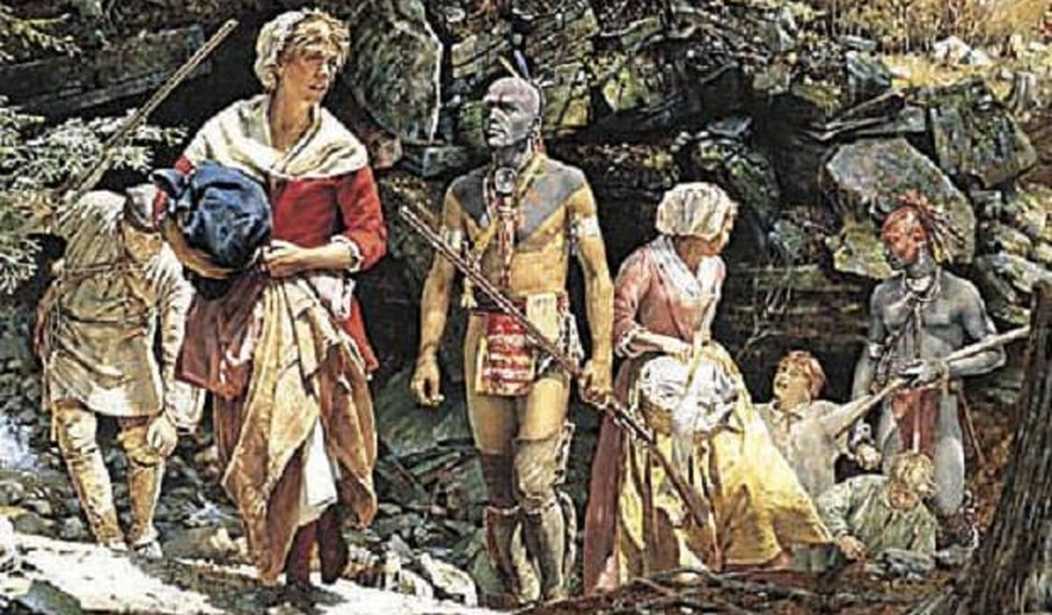July 30 started out normal in the frontier settlement of Drapers Meadow, Virginia (this corresponds roughly to the campus of Virginia Tech in Blacksburg, VA). The locals, about twenty settlers — mostly Ulster Scots but with a few Palatine Germans thrown into the mix — were carrying out their daily chores. Mary Robertson Draper was doing laundry in a creek. John Draper, Mary’s husband, and William Ingles* were mowing hay. William Ingles’s wife, Mary Draper Ingles, was taking care of children. Mary’s mother, Eleanor Draper, was walking with her grandson, Thomas Ingles.
There were two significant visitors to the settlement. The County Lieutenant, Colonel James Patton**, and his nephew William Preston were delivering gunpowder for local defense. General Braddock’s army had been defeated on the Monongahela on July 9 and the Virginia frontier was bracing for enemy, specifically Indian, attacks. The backcountry settlers were perpetually low on gunpowder and this small shipment was of such import that the sole master of Augusta County was delivering it to his people in person. That morning, Patton was writing correspondence in a cabin he maintained in the settlement. He had sent his nephew on an errand to the outlying home of Philip Lybrook***
Sometime around mid morning a Shawnee war party originating in Lower Shawneetown (present day South Portsmouth, KY) attacked. In short order the community was destroyed. James Patton was killed in his cabin. According to family legend the 6’4″ Patton cut down at least two Indian warriors with a claymore before succumbing. Eleanor Draper was tomahawked and scalped. Betty Draper’s infant child was brained against the side of one of the cabins. An old German named Casper Barger (Kaspar Bargar) was tomahawked. William Ingles and his brother-in-law, John Draper, were surprised mowing hay. The took to their heels. John ran away. William, according to story, tripped while vaulting a downed tree and had the presence of mind to crawl back under the tree trunk rather than get up and run.
Mary Ingles, her young sons George and Thomas, Betty Draper, and two unrelated men, James Cull and Henry Leonard (Leinert) were all captured. They were force marched across Flat Top Mountain (where my great grandfather was born) up the New River/Kanawha River Valley to the Ohio and then to Lower Shawneetown. As the war party was leaving they stopped by the home of Philip Lybrook and his wife and gave them the head of Casper Barger in a sack and continued on their way leaving the Lybrooks unmolested.
Mary Ingles was very, very pregnant when she was captured. Only a few days on the trail she gave birth to a daughter. So the journey was a harrowing one. When they arrived at Lower Shawneetown, both Leonard and Cull failed the ordeal of ‘running the gauntlet’ and were tortured to death. Mary’s sons were adopted into Indian families to replace lost warriors.
In late October, Mary and some other captive women were taken from Lower Shawneetown to Big Bone Lick (no, this is not a porn flick) to boil the salt water into salt. With an “old Dutch woman” (Dutch=Deutsch=German) they stole away from the camp. Mary Draper made the decision to leave her daughter behind because she knew the infant could not survive the ordeal in front of them.
Without food, fire, or tools the two women traveled retraced the route taken by the war party that had captured Mary. The two of them traveled about 500 miles in 42 days in the dead of winter. She dropped her traveling companion around what is now Glen Lyn, VA, when the old woman decided that cannibalism had a certain appeal. They traveled down opposite sides of the New River until Mary Draper was discovered by her neighbor, Adam Harman, on December 1, 1755, in what is now Pembroke, VA. The old German woman survived also.
In 1761, Thomas Ingles was discovered among the Indians and ransomed. He never completely readjusted to life in the English settlements. He would periodically take off for long periods of time.
Betty Draper was ransomed in 1768 and resumed her marriage with John Draper.
George Ingles died in captivity. The fate of Mary’s infant daughter is unknown.
The attack on Draper’s Meadow marked the first major attack by Indians on the colonial frontier of the French and Indian War. Often the attacks were led by French officers. Mary Draper Ingles, for instance, took shelter in Fort Vause in present day Shawsville, VA. On June 25, 1756, 205 Shawnees and 25 French Canadians led by a French Military officer, François-Marie Picoté de Belestre, Sieur de Belestre, attacked the fort. About 150 settlers were captured. Only good fortune prevented her from being taken prisoner yet again.
What followed was a very sophisticated campaign designed to denude the areas west of the Blue Ridge of settlers. Not only were farms burned and settlers killed but livestock was slaughtered and fruit trees cut down. Historically, the Shawnee and their closest allies the Delaware had raided for prisoners. Now it became common for prisoners to be dismembered and disemboweled and the remains left were pursuing militia were sure to find them. By 1763 most of the Virginia frontier beyond Winchester was completely depopulated.
============
*You often hear the name Ingles pronounced ENgels as though it was German or Scandinavian. The pronunciation of the name is English, it often appears that way in Augusta County records, and the family were Ulster Scots.
**Patton is an interesting character. He was a former merchant ship captain. He was County Lieutenant, which meant commander of all military forces in the county. He was colonel of the county’s militia regiment. He was president of the county court, which in colonial Virginia acted as a combination judicial and legislative body. He was county coroner. He was county customs collector. He was county sheriff. He was county escheator, which is the official charged with disposing of the property of the intestate. He was president of the Augusta Anglican parish and president of the commissioners that governed the largest Presbyterian congregation (Tinkling Springs) west of the Blue Ridge. He was also the largest single landowner in the county controlling at least 100,000 acres.
***Actually, Leibroch. He was part of the Palatine community. The founder of the settlement was Adam Harman (Hermann).
The illustration is The Taking of Mary Jemison by Robert Griffing.













Join the conversation as a VIP Member